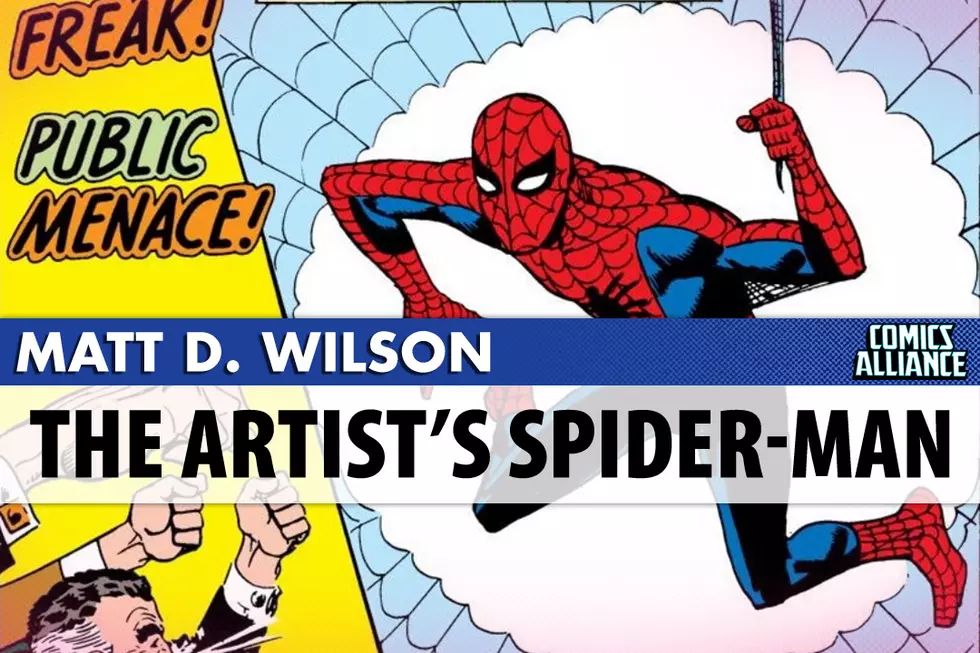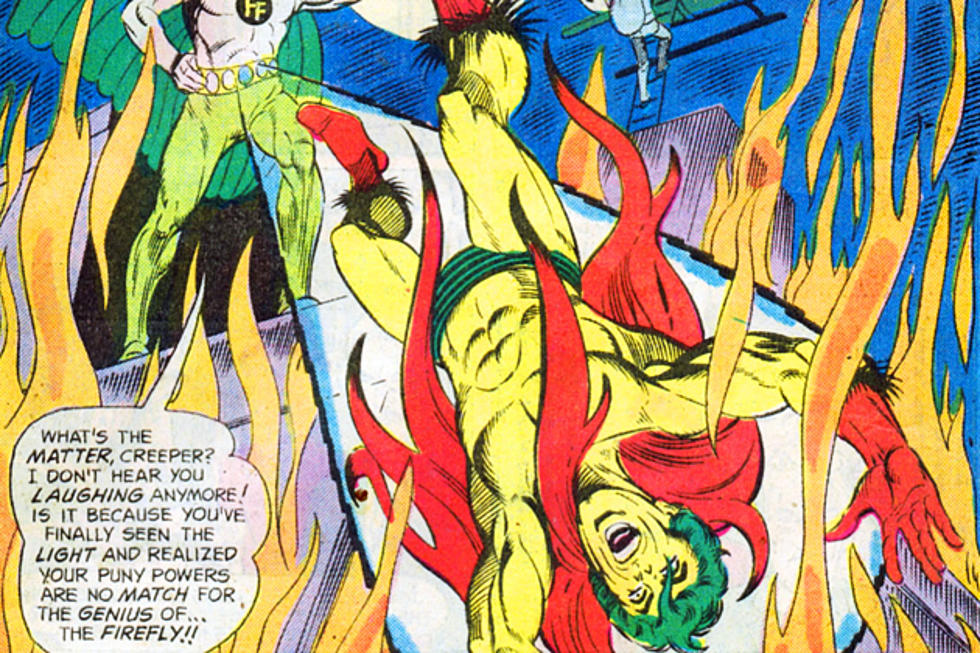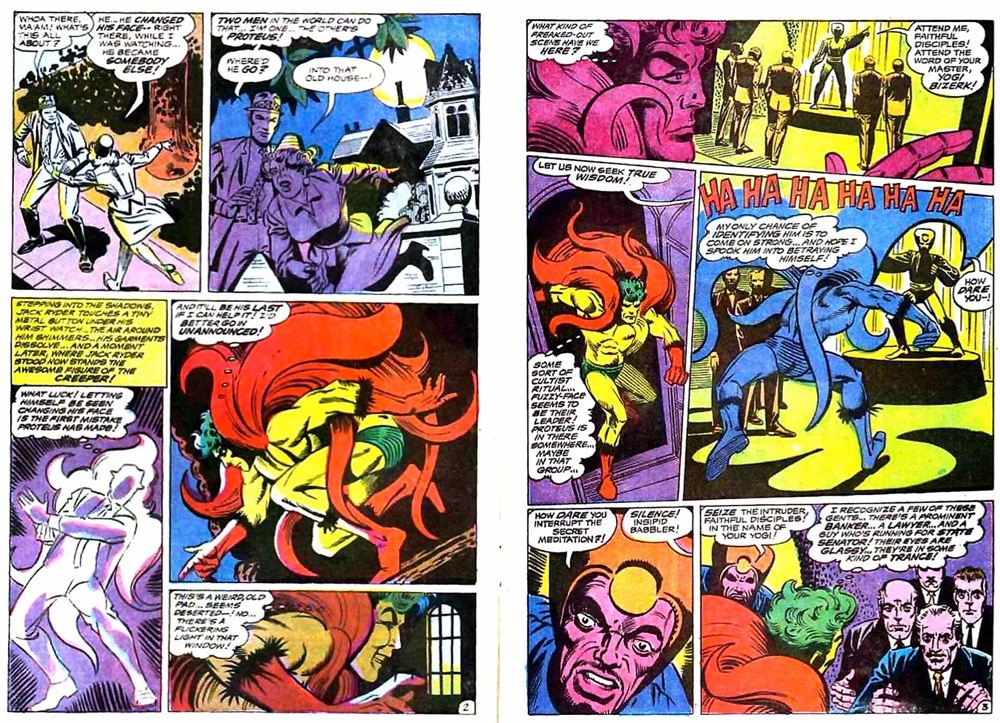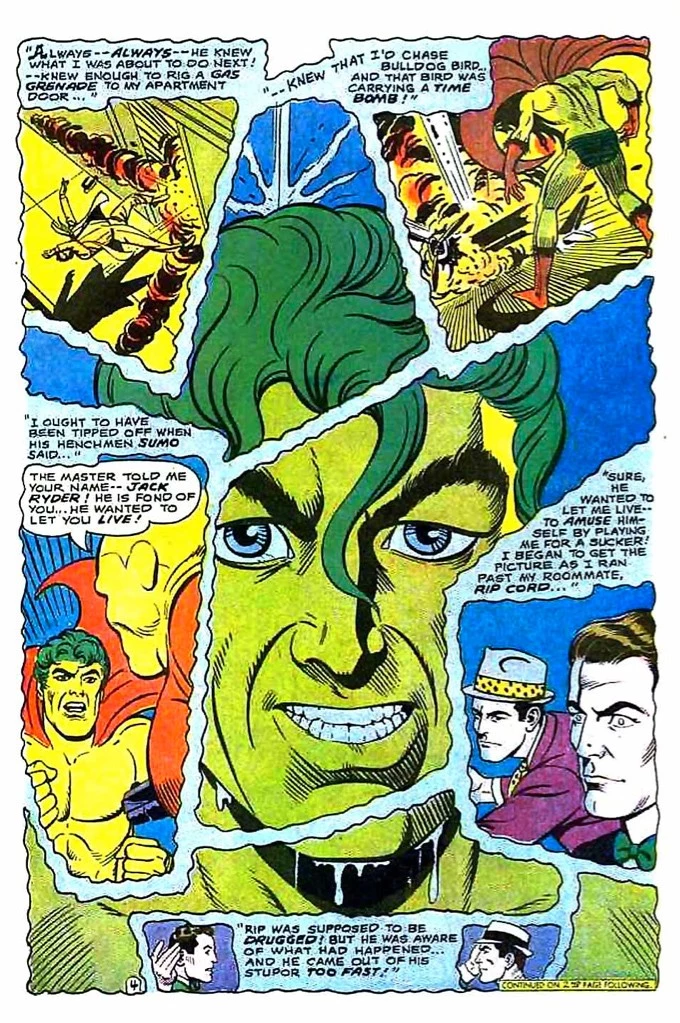
Mania and Dream Logic: Looking Back at Steve Ditko’s Cackling ‘Creeper’
 The Creeper isn't the greatest Steve Ditko creation, and it's not even the most Ditko-esque. (Maybe those are the same things.) But one thing the Creeper comics have going for them is that they follow their own unsettling dream logic, and Ditko commits to the mania that powers the title character. This is a costumed vigilante who dresses in yellow body paint, wears a green wig, and sports a freaky red shag carpet over his shoulders, to complement his fur-lined boots. Raging reporter Jack Ryder first dons the outlandish outfit to sneak into a costume party where he suspects criminal activity, and he keeps it because of a knife wound and super-science. It bonds with him thanks to a desperate injection and a conveniently-timed hyperspace implant, and the Creeper is born.
The Creeper isn't the greatest Steve Ditko creation, and it's not even the most Ditko-esque. (Maybe those are the same things.) But one thing the Creeper comics have going for them is that they follow their own unsettling dream logic, and Ditko commits to the mania that powers the title character. This is a costumed vigilante who dresses in yellow body paint, wears a green wig, and sports a freaky red shag carpet over his shoulders, to complement his fur-lined boots. Raging reporter Jack Ryder first dons the outlandish outfit to sneak into a costume party where he suspects criminal activity, and he keeps it because of a knife wound and super-science. It bonds with him thanks to a desperate injection and a conveniently-timed hyperspace implant, and the Creeper is born.
That's the absurd origin of the Creeper, and it's one that was revised and rewritten in the decades after Steve Ditko stopped working on the character. It doesn't make any kind of sense. Jack Ryder infiltrates a costume party with the most blatantly noticeable costume in the history of costumes? And the guy he's there to sort-of rescue happens to have a super-serum inside a ready-to-go syringe that gives Jack Ryder super-healing and super-strength? And not only that, but the genius implants a displacement field inside Ryder's gaping wound because arms dealers and warlords could use it to make stealth armies? What now?
Yet, that's what we get in the opening story, and we go with it, because in Ditko's odd universe what matters is the strangeness, not the believability. It's spectacle, but not of the sort with cosmic crashes and dynamic gestures. Instead, it's the sordid, unsettling kind, the equivalent of a gang of clowns piling out of a Volkswagen and pulling the mask off the ringleader to reveal that he's a criminal mastermind who once pretended to be your best friend. That kind of vibe. You may have had nightmares like that after eating too many slices of bacon and goat cheese and anchovy pizza.It was Dan Clowes that convinced me that Steve Ditko's superhero comics were worth reading. I'm sure Clowes has spoken or written about his appreciation of Ditko, but that's not what I'm talking about. And it might be difficult to believe that Ditko, the creator of many of my favorite childhood comic book characters like Spider-Man and Doctor Strange and the Question and the Blue Beetle, would be someone I often overlooked as an artist. But I did. I avoided Ditko's work for years, finding his doll-like poses and long shots and big-toothed, rubbery-faced characters antithetical to what I enjoyed about superhero comics. His comics looked, to me, like a kind of puppet theater. His characters were marionettes bouncing around on a colorful but ultimately uninteresting stage.
It probably didn't help that I grew up on ROM Spaceknight and Speedball Steve Ditko, lesser artistic works by any standard (except the perils of nostalgia), and knew his more famous characters via interpretations by other writers and artists, so his versions of his own creations looked quaint and archaic. But it wasn't just that. I had learned to love Jack Kirby by then, even though I didn't grow up with his seminal work. And I liked Gene Colan and Don Heck and other Silver Age artists just fine. But I never quite understood the appeal of Ditko.
It wasn't until the mid-1990s when my brain shifted into the right mode. I had been reading a lot of Dan Clowes by then -- his Eightball remains one of my favorite comics of all time -- and I thought about a reality in which someone like Clowes would get a chance to (or even want to) draw a sustained run on a superhero comic. That's when I realized that it had already happened. Many times. Steve Ditko was the weird outsider who drew atypical superhero comics with what could, in retrospect, be called a proto-alt-comics aesthetic. I had been misreading his comics for years.
I'm sure Ditko would hate such labels. "Proto-alt-comics aesthetic" probably sounds like a whole bunch of nonsense. But that was my way into his world. That was the perspective that allowed me to appreciate Ditko for what he was, not what he wasn't. Since then we've had a substantial Steve Ditko renaissance, with the more literary-minded comic book critics reminding everyone that Ditko is still out there, drawing comics in his mid-eighties, producing his own idiosyncratic small press work for mail order customers. And major publishers have brought many of his comics back into print, via sometimes glossy and always decently-expensive hardcover editions. Biographer and editor Blake Bell, specifically, has teamed up with Fantagraphics to remind all of us that Steve Ditko matters, thanks to their line of Ditko-focused art books and reprints of long-forgotten masterpieces.
That's all a long lead-in to a simple fact: I read 2010's DC Comics release The Creeper by Steve Ditko and I liked it.
(click image to enlarge)
Ditko isn't the credited scripter on all of the stories collected in this volume, and the tone shifts around a bit depending on who fills in the word balloons, but the underlying stories are of the odd and unusual Ditko variety. When Denny O'Neil (under his own name or under the pseudonym Sergius O'Shaghnessy) writes the dialogue, the Creeper stories become a bit more crime-and-revenge oriented. When Michael Fleisher writes the script for the Creeper's appearance in First Issue Special #7, a third-rate Batman villain becomes the subject of mockery and the whole story takes on an air of ironic confidence. When Ditko writes the Creeper backups in World's Finest Comics, the strip becomes a freakshow gallery, like a bounding Dick Tracy lineup. His run ends with "Furious Fran and the Dagger Lady," and what's interesting about the Dagger Lady is that she has dozens of daggers strapped to her body, including two attached to her head, and she throws them. Hard. It's silly and wonderful and Ditko seems interested only in amusing the audience and nothing more.
But he does it his way. There's nothing commercial about any of the comics in this collection. The Creeper is an unattractive, almost accidentally heroic protagonist. He does punch out plenty of criminals, but only because he's there and punching is what needs to be done. He's no altruistic knight in yellow body paint. Nor is he a justice-bound avenger. He's just a reporter who doesn't do much reporting and gets caught up in weird activities mostly because everyone in the world seems to want to cause trouble in and around the television station. So he presses his magic button and turns into the Creeper, cackling weirdo of...whatever is in front of him.
Perhaps Steve Ditko's Creeper stories show his rejection of traditional superhero tropes, and his celebration of the odd creatures who lurk at the fringes of society. That may be it. But they don't seem to even have that much on their mind. Instead, the Creeper stories are about off-beat, jaunty enthusiasm for action over inaction. They are about colorful characters doing colorful things, via the mind of Steve Ditko circa 1968. In that proto-alt-comics kind of way.
The Creeper by Steve Ditko is on sale now in finer comics shops and bookstores.
More From ComicsAlliance

![Christopher Priest, Denys Cowan, And Bill Sienkiewicz Team Up For ‘Deathstroke’ #11 [Exclusive Preview]](http://townsquare.media/site/622/files/2017/01/DS_Featured.jpg?w=980&q=75)











